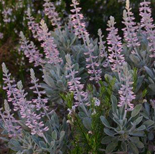Lupinus aridorum
| Lupinus aridorum | |
|---|---|
 |
|
| Scientific classification | |
| Kingdom: | Plantae |
| (unranked): | Angiosperms |
| (unranked): | Eudicots |
| (unranked): | Rosids |
| Order: | Fabales |
| Family: | Fabaceae |
| Subfamily: | Faboideae |
| Tribe: | Genisteae |
| Genus: | Lupinus |
| Species: | L. aridorum |
| Binomial name | |
|
Lupinus aridorum McFarlin ex Beckner |
|
Lupinus aridorum is a rare species of lupine known by the common name scrub lupine. It is endemic to Florida in the United States, where there were 10 known populations remaining in 2003. Fewer than 6000 individual plants were counted. It is threatened by the loss and degradation of its habitat. The scrub lupine is a federally listed endangered species of the United States.
This plant was first collected in 1900, but it was not described until 1982 to science as a species. It is often treated as a variety of Lupinus westianus.
The scrub lupine is a biennial or perennial herb growing up to a meter tall. The leaves are oval with pointed tips, not palmate as in most other lupines. Each leaf blade may be up to 7 centimeters long by 4 wide and is borne on a long petiole. The herbage is coated in silvery hairs. The inflorescence is a raceme-like spike of flowers up to 15 centimeters long borne on an erect stalk up to 13 centimeters in length. Each pealike flower is between 1 and 2 centimeters long and pale pink in color with a darker spot on the standard, or top, petal. The fruit is a hairy legume pod about 2 centimeters long. The plant is known to reach seven feet in diameter. The scrub lupine is easily identified in its habitat, being the only upright-growing lupine that has pink flowers.
The plant grows in the Florida scrub of Central Florida. It grows in well-drained white sand, or sometimes yellow sand, among sand pines (Pinus clausa). Other trees in the habitat may include slash pine (Pinus elliottii) and turkey oak (Quercus laevis). Shrubs in the understory include the Florida rosemary (Ceratiola ericoides), scrub live oak (Quercus geminata), and rusty lyonia (Lyonia ferruginea).
...
Wikipedia

